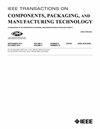Miniaturized Millimeter-Wave Multilayer Filter Design Using Additive Manufacturing
IF 3
3区 工程技术
Q2 ENGINEERING, ELECTRICAL & ELECTRONIC
IEEE Transactions on Components, Packaging and Manufacturing Technology
Pub Date : 2025-04-24
DOI:10.1109/TCPMT.2025.3564215
引用次数: 0
Abstract
This article presents an innovative, fully additive manufactured approach to millimeter-wave multilayer circuits. An aerosol jet printer is used to fabricate a multilayer stepped-impedance low-pass filter. By leveraging the second layer for miniaturization, we achieve a more compact design. By precisely controlling conductor separation and utilizing 3-D printing technology, we were able to optimize the width of the high- and low-impedance segments for optimal filter performance. Two filter types were successfully fabricated: a low-pass microstrip filter and a low-pass stripline filter, both with a cutoff frequency near 29 GHz and exhibiting acceptable stopband attenuation. The stripline configuration allows for a 36% decrease in the stripline waveguide conductor area while achieving a great passband insertion loss of just 0.62 dB, enabled by aerosol jet printing (AJP). The line loss of both designs was characterized using a microstrip through line and a stripline through line. Both designs demonstrated low overall loss, with the microstrip line exhibiting a loss of 0.26 dB/mm and the stripline having a loss of 0.37 dB/mm at 29 GHz. This work demonstrates a multilayer integration solution and offers an advantage in reducing the size of RF circuits such as filter banks for next-generation integrated RF front ends.利用增材制造技术设计小型化毫米波多层滤波器
本文提出了一种创新的、全增材制造毫米波多层电路的方法。利用气溶胶喷墨打印机制备了多层阶跃阻抗低通滤波器。通过利用第二层实现小型化,我们实现了更紧凑的设计。通过精确控制导体分离和利用3d打印技术,我们能够优化高阻抗和低阻抗段的宽度,以获得最佳的滤波器性能。两种类型的滤波器被成功制造:低通微带滤波器和低通带状线滤波器,两者的截止频率接近29 GHz,并表现出可接受的阻带衰减。带状线配置允许带状线波导导体面积减少36%,同时通过气溶胶喷射打印(AJP)实现仅0.62 dB的巨大通带插入损耗。两种设计的线路损耗都是用微带穿过线和带线穿过线来表征的。两种设计都显示出较低的总损耗,微带线在29 GHz时的损耗为0.26 dB/mm,带状线的损耗为0.37 dB/mm。这项工作展示了一种多层集成解决方案,并在减少下一代集成射频前端的RF电路(如滤波器组)尺寸方面具有优势。
本文章由计算机程序翻译,如有差异,请以英文原文为准。
求助全文
约1分钟内获得全文
求助全文
来源期刊

IEEE Transactions on Components, Packaging and Manufacturing Technology
ENGINEERING, MANUFACTURING-ENGINEERING, ELECTRICAL & ELECTRONIC
CiteScore
4.70
自引率
13.60%
发文量
203
审稿时长
3 months
期刊介绍:
IEEE Transactions on Components, Packaging, and Manufacturing Technology publishes research and application articles on modeling, design, building blocks, technical infrastructure, and analysis underpinning electronic, photonic and MEMS packaging, in addition to new developments in passive components, electrical contacts and connectors, thermal management, and device reliability; as well as the manufacture of electronics parts and assemblies, with broad coverage of design, factory modeling, assembly methods, quality, product robustness, and design-for-environment.
 求助内容:
求助内容: 应助结果提醒方式:
应助结果提醒方式:


